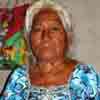 |
 |
 |
 |
|
||||||||||||||||||||||||||||||
|
The Popoloca of Puebla The Aztecs used the word "popoloca" to describe peoples who spoke languages other than Náhuatl, their own tongue. Popoloca is the modern Mexican name for the N'Guiva people who live in the southern part of the state of Puebla. (The Popoluca people who live in Veracruz belong to an unrelated ethnic group). Linguistically, the N'Guiva speak an Otomanguean language that belongs to the Popolocan language family which includes Popoloca as well as 3 Oaxacan languages - Mazatec, Chochotec, and Ixcatec (which is probably extinct). The Popoloca of Puebla are closely related in terms of language and culture to the Chocho (Ngigua) people of northern Oaxaca. Only 14,499 people spoke Popoloca according to the 2000 census. For centuries (into the present day) both Spanish and Náhuatl have been replacing the Popoloca language, and many Náhuatl-speaking indigenous people in southern Puebla were once Popoloca speakers. The ancestors of the Popolocas probably emerged as a distinct ethnic group between 900-200 BC. When the Popolocas were at the height of their political power, after 700 AD, their territory covered much of central and southern Puebla, as well as parts of Tlaxcala, Guerrero and northern Oaxaca. In the 15th and 16th centuries the Aztecs advanced into Popoloca territory and conquered all of their sophicated chiefdoms except Cutha. Popoloca chiefs were required to send blue and black cotton textiles, lime, deerskins, and canes used for atlatl shafts to Tenochtitlán as tribute. Today, Popolocas live in three non-contiguous regions of southern Puebla. One area includes the municipalities of Tlacotepec and Tepanco northwest of Tehuacán. The second includes the municipios of Zapotitlán and San Gabriel Chilac south of Tehuacán. The 3rd and largest area is located west of Tehuacán and includes the municipios of Tepexi de Rodríguez, Ixcaquixtla, Ahuatempan, and Coyotepec. Geographic and cultural isolation has led to great linguistic diversity. At least 7 regional variations of the Popoloca language are spoken today, several in only one town. Maize farming was traditionally the principal economic activity of the Popolocas, but small plots, poor soils, and lack of rainfall have caused many people to leave the land for wage labor in central Mexico's big cities and in the US - a frequent destination is the New York City area. Many women and girls have gone to work in the clothing factories of the Tehuacán valley. Though much of Popoloca land is bad for farming, it's good for raising large herds of goats. Some families also raise turkeys, chickens, and pigs. Many men work the mines near Zapotitlán which produce onyx and marble that is worked in Puebla City. Women potters from Los Reyes Metzontla have become well known nationally for the quality of their ceramics, and pottery making is also a traditional craft in San Juan Atzingo. Around Tepexi de Rodríguez women trade or sell the mats and baskets that they weave from palm leaves. Today, some communities that have lost their original language are trying to find their "roots" and reconstruct past histories. Though the Popolocas are one of Mexico's smaller indigenous groups, the N'Guiva people are actively trying to preserve their endangered language and traditional culture, of which they remain very proud. |
|||||||||||||||||||||||||||||
|
||||||||||||||||||||||||||||||
